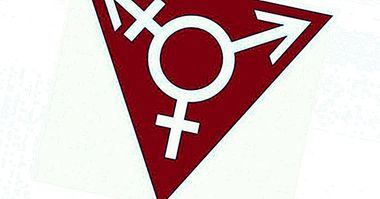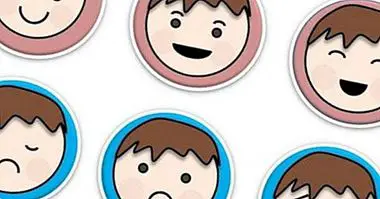Anomia: description, causes, symptoms and treatment
"What was it ... that we used to eat soups or creams, so round at the tip?" . The word that most people come to mind is "spoon".
It is a name, a label that refers to a certain concept that the person who has asked the question knows, but can not access. And although it is usually a momentary lapse, sometimes we are faced with a frequent event in which the individual does not remember the name of things. It's about the language disorder called anomia .
Anomia: description and symptoms
The concept of anomie refers to the presence of difficulties in naming an object or concept , that is, to access or produce the name or label with which we designate it. It is a problem that can appear in many circumstances, being in some cases something normal as occurs before a lapse or during aging while in others it can be a symptom of a more or less important alteration. The difficulty is mainly in the use of nouns, being more infrequent that there are problems with verbs, adjectives or adverbs.
In general, the person with anomie tends to use circumlocutions to make the receiver of his message understand what he is trying to say, using for example semantic keys such as what the object in question is used for, its form or what happens during said situation or phenomenon. . It is also common the use of phrases and expressions to buy time, or more general categories that include the concept with which they have difficulties (if they are not able to access the name "dog" can say for example "animal").
Patients and subjects who frequently present anomie tend to experience it with discomfort or even worry , since most of them are fully aware of what they want to say despite not finding a way to represent it.
Types of anomy
Although the anomie as a whole tends to be considered, the truth is that there are several aspects that can cause that it is not remembered or a specific name can be issued. Three major types of anomie stand out.
1. Lexical anomia
The purest and most known form of anemia occurs when the element that fails is the ability to access the word despite knowing clearly what it refers to . It is not that he does not know how to pronounce the word or what concept he is referring to, but that he is not going to represent in his mind the label itself. It is the type of anomie corresponding to the example of the introduction.
2. Phonological anomia
This type of anomie occurs when, despite knowing what concept you want to refer to and what your name is , the subject is not able to find its representation at the phonetic level, not knowing what to say to name it. It is frequent in aphasias in which the production of language is altered, as in Broca's.
3. Semantic anomie
The problem in this type of anomie occurs when conceptualizing, existing cognitive and memory problems . It is not that he could not pronounce the words or that he does not find the right label for a concept, but that he is not able to identify it.
The anomia in aphasias
Anomie is a common symptom present in many aphasias, those alterations and losses of the ability to produce and / or understand the language caused by brain injury.
However, although it is usually one of the multiple symptoms that occur in different types of aphasia, if it appears without other language alterations it can constitute the so-called anomic aphasia. This type of aphasia is characterized because the language of the person is fluent , there are no difficulties in understanding the language and if asked to repeat the same words he does it without difficulties. So the only perceptible alteration is anomie.
The anomic aphasia also corresponds to the semantic aphasia of the classification proposed by Luria, although there are nuances that separate them. In this case the ability to name and find the word in question is altered because the subject is not able to choose between different options, presenting other problems such as the difficulty to understand complex relationships at the logical level.
Another type of aphasia especially linked to anomie is acoustic-amnesic semantic aphasia, in which the subject does not remember the phonetic form of the word in question that he wants to use. Knows what it is but not as it is said, also presenting problems when storing and replicating series of words.
Contexts and causes of appearance
Anomie can appear in multiple contexts, not all being clinical. For example, in the extreme phenomenon of the language a difficulty appears to remember a word, although the problem is more of memory than of language (we would be before a case of lexical anomie).Also with age it is common to suffer a certain degree of anomie due to the aging of the brain
Clinically, anomie can appear in a large number of mental and organic disorders. The presence of lesions in different areas of the brain linked to language is especially relevant. The most related to anomie are the areas of Broca from 37 to 39 (including the angular turn) and other areas of tertiary association of the parieto-temporo-occipital zone. Likewise, if the problem is found in the formulation or choice of the concept, there is also a great influence of the frontal lobe.
These injuries and alterations are frequent in traumatic brain injuries and cerebrovascular accidents . It is also very frequent its appearance in dementias, such as Alzheimer's or some frontotemporal as semantic dementia.
Treatment
In cases where it is not a slight lapse but a truly anomic subject , the treatment to be applied will depend to a great extent on where the problem is. In any case, rehabilitation tends to be required from a multidisciplinary perspective, in which the role of language therapy through the use of speech therapy will be highlighted. In other cases, especially in dementia derivatives, occupational therapy can be very useful.
Among the activities to be applied have shown to be successful the use of tasks of pairing between drawings and words or tasks in which they must judge whether different words are or not synonymous in cases of semantic anomie, and in case of pure or lexical anomies use tasks in which can be used phonetic clues, as well as priming (first the word is presented and then the drawing of the concept or element), tasks to complete words and / or sentences or generation of rhymes. In cases of phonological anomy, reading aloud and imitation and repetition tasks are often useful. .
Bibliographic references:
- Castejón, L. and Cuetos, F. (2006). The rehabilitation of anomie from a multidimensional perspective. Journal of Speech Therapy, Phoniatrics and Audiology 26 (2); 101-114.
- Cuetos, F. (2003). Anomia: The difficulty to remember the words. Madrid: TEA Editions.
- Santos, J.L. (2012). Psychopathology. CEDE Preparation Manual PIR, 01. CEDE. Madrid.



















